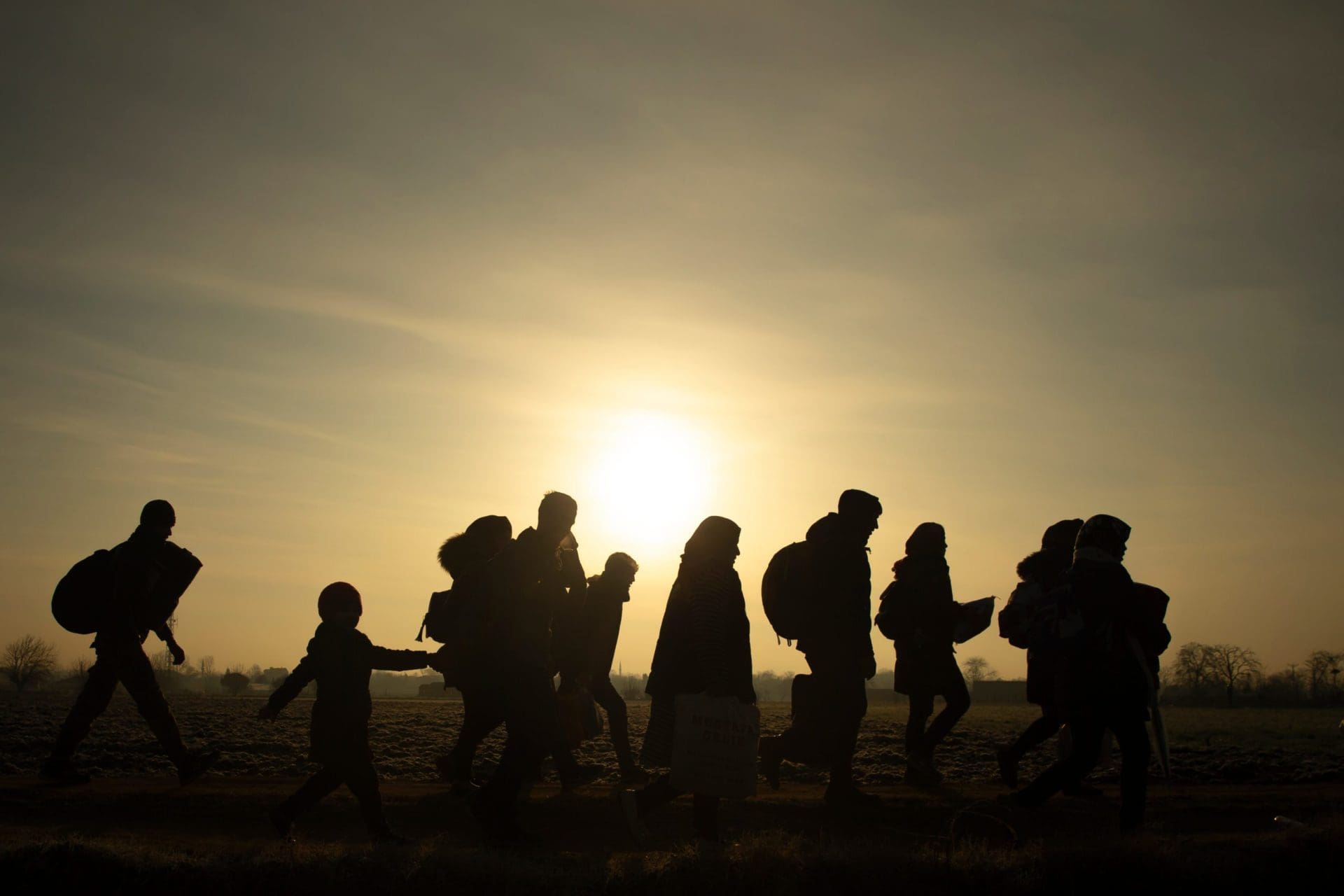Introduction
The current mass migration to Europe may seem spectacular and worrying in many respects, and indeed, we are confronted with the greatest threat to European identity the continent has faced since the Spanish Reconquista and the Ottoman Wars. However, this evolution is neither the exclusive result of any form of real or alleged ‘climate change’, nor ‘new’ from a world-historical point of view; on the contrary, as has been convincingly shown by Spengler and Toynbee,1 all civilizations, independent of their technological level, are subject to mass migration once they reach the final stage of their respective evolution, and, sooner or later, see their traditional ethnic identity and social cohesion threatened.
For many of today’s historians, the obvious fact that certain historical patterns frequently repeat themselves throughout world history seems to be reason enough to minimize their impact and gravity, or even to appeal to a certain form of inertia and resignation: what happens time and again ought rather to be accepted as a historical constant, and perhaps even welcomed. I, however, though in agreement that the main outline and course of every civilization is roughly analogous, would prefer to underline the fact that, while we cannot entirely change or deflect the general tendency of civilizational history, we do in fact possess some room for manoeuvre, which we can use to our benefit.2 In the following, we will examine a series of select examples of mass migration throughout history.
Mass Migration in History: Classical Antiquity
The most well-known example of mass migration comes, of course, from classical antiquity. Readers may expect me to focus on the migration of peoples during late antiquity, when entire tribes moved from the Germanic regions into the Roman Empire, slowly but steadily destroying its institutions and infrastructure while forming kingdoms of their own, which, in the end, led to the fragmentation and dissolution of the Roman Empire, at least in northern and western Europe. However, tempting though such a comparison might be, this is not the most important parallel to the present situation in my eyes. As the readers of my book, On the Path towards Empire, may know, I prefer to seek parallels between modern Europe and the late Roman Republic, in the first century BC, which seems morphologically much more similar to our own period.3
Thus, already during the Republic, Rome became a point of convergence for great masses of people, largely drawn from the east of the Mediterranean world, who wanted to benefit from the numerous possibilities and amenities offered by the new Italian megapolis.4 The number of immigrants from Syria, Asia Minor, Mesopotamia, and Judaea reached such levels that the question of whether or not to expel them all from Italy was debated for many years, dividing those who believed in Stoic cosmopolitism and those wanting to guarantee the cultural and ethnic homogeneity and solidarity of the Roman people. In the end, the influx of migrants became too large to be controlled, especially since the many prisoners and slaves imported to Rome sooner or later gained their liberty, so that Rome gradually became a multicultural city in which the Romans themselves felt in the minority.
Once Rome started to allow the influx of large migrant groups from outside the Empire, the situation got out of hand
The only possible solution was implemented by Emperor Augustus, whose legislation tried to combine pro-natalist politics with a drastic reduction in the granting of civic rights to immigrants. He also sought to establish a new ‘leading culture’ that would make it possible for ambitious migrants to become a full part of the Roman society only when they became assimilated to the Roman way of life.5 This integration functioned fairly well for many decades, and even the opening of the army to auxiliary forces from peripheral territories was to become a strong cement for the cultural cohesion of the Empire. However, once Rome started to allow the influx of large migrant groups from outside the Empire and, what is more, permitted them to settle as coherent groups under their own laws instead of being scattered throughout the entire realm, the situation got out of hand, and ultimately led to the Germanic take-over of the Roman army and the foundation of barbarian kingdoms on Roman soil.
A Short Excursion into World History
But of course, classical antiquity is not the only era which experienced a similar process of ethnic fragmentation and difficult cultural reconstitution; we could say with a certain degree of confidence that virtually all other civilizations have gone through analogous episodes.
We could, for example, refer to the ancient civilization of Sumer, a sedentary society which increasingly came under threat from the nomadic Amorite people, who not only drifted in from the desert fringes, but also from the north of Mesopotamia.6 Already prior to this, the Sumerians had established a cultural symbiosis with the Semitic Akkadians, who had become an integral part of Sumerian society; the Amorites, however, proved less easy to integrate. Thus, for many decades, they established their dwellings among the Sumerians, bringing with them their cult, language, and traditions, and were increasingly perceived as a menace. In the end, the Sumerians, unified under the Third Dynasty of Ur, had to build enormous walls in order to protect their territory from the immigrants.7 Nevertheless, in the end, the Amorites overcame Sumer from without and within and founded their own dynasties, trying to establish a cultural fusion between their own traditions and those of the host civilization.
A similar evolution is known from Pharaonic Egypt. Here, it was the Libyans from the Western desert and the numerous Canaanite peoples from the east who gradually established themselves in the delta region, partly as prisoners of war, partly as mercenaries, partly as simple immigrants.8 Initially, they were met with great hostility from contemporary writers and evidently also the Egyptian people. This hostility became even more pronounced as their numeric importance steadily grew and as they kept, despite superficial Egyptianization, their language, customs and gods. This fragile equilibrium started to tip at the end of the Ramesside dynasty,9 when the Libyans finally took over the state and established their own dynasties. Ironically, it was the Kushites, a strongly Egyptianized people from the southern Nile region who had been long-despised by the Egyptians, who rose in defence of Egyptian civilization and its gods, and liberated the Nile valley from its Libyan overlords, only to be overthrown, shortly afterwards, by the Assyrians, then a series of subsequent conquerors.
Another example of large-scale immigration comes from ancient China, where the different kingdoms from the ‘Warring States’ period had an uneasy relationship with their northern nomadic neighbours from the Mongolian steppes, the ‘Hu people’.10 For centuries, life in the north was dominated not only by mutual attacks and the building of the Great Wall, but also by a gradual influx of nomads into the Chinese kingdoms and, after the establishment of the sole rule of Qin Shi Huangdi, of the Empire.11 Though the nomads very quickly took over key elements of Chinese civilization, they in turn strongly influenced China. Both groups remained distinct from each other, and in the end, after the collapse of the Han Empire, the revolt of the ‘Five Barbarians’ led to the fragmentation of China into sixteen contending principalities.
In the same spirit, let us also examine the situation in the late classical Islamic world. Here, it was the Turks from Central Asia who gradually penetrated the Muslim civilizational space.12 At first, they were recruited as simple mercenaries and porters, but their political importance was growing even during the Abassid Caliphate, as they began to take control of central military and administrative offices until, in the end, they even transformed the caliph into mere puppet. Though at least in the west of the Islamic Empire, the Fatimid Caliphate succeeded in creating a new cultural equilibrium,13 this political takeover paved the way for a large-scale immigration of entire population groups from Central Asia into the Muslim core provinces, and though they readily adopted Islam and its civilization, they kept their own languages and customs, and began to establish their own independent states. Of these, the Seljuks were certainly the first and the most impressive, but even in places where, as in Egypt, the immigrants did not form a numerical majority of the population, they successfully gained control of the state through their involvement in the army, as in the case of the Mamluks. One of these Turkic States, established in western Asia Minor, ultimately became the core of the later Ottoman Empire, which was to encompass most of the Muslim civilizational space.
We could enumerate many further examples,14 such as the probable responsibility of Indo-Aryan migrants for the end of the Harappa civilization, the importance of Central Asian nomadic migration for the Indian subcontinent of the Kushan period, or the impact of the Manchus on the declining Ming dynasty in Buddhist China, but the general outline of the argument would be largely the same as in the instances already sketched above. Let us thus advance some comparisons.
Comparing Civilizations
First, let us state once again that mass immigration is not a ‘new’ phenomenon in history: all late civilizations have to face this phenomenon. Why does this happen towards the end of a civilization, while in earlier times, we either see no similar mass immigration or, when it occurs, it quickly leads to a large cultural fusion of the newcomers with the people already present, as was the case among the early medieval Normans or Hungarians? This is a difficult question, and cannot be comprehensively answered here; let us merely hazard the hypothesis that early societies still possess a form of identity—ibn Khaldun would say ‘Asabiyya’15—that is both strong and flexible, and enables the rapid integration and even assimilation of newcomers, while older civilizations seem largely paralysed in an identity that is merely a formal, outer garb, increasingly devoid of inner meaning or civilizational strength.
As to the connection between mass migration and climate, there is much that can be said from a comparative perspective, though the study of climate evolution is still in its infancy. However, what is already emerging from our evidence is that all late civilizations tend to over-exploit their own environment, and not only generate phases of strong population growth, but also trigger, through monocultures and the disruption of natural equilibria, occasional scarcities, thus making the spreading of pandemics easier.16 Nevertheless, this concerns essentially their own civilizational space, not the outside world, and mass immigration seems not to be the result of any major outside disruption, but rather the attraction of the highly developed and fertile space constructed within the boundaries of these civilizations. Of course, this attraction, together with the impact of export goods easing the life of people outside, can constitute a destabilizing factor, usually provoking demographic growth which outstrips production potential, thus paving the way for mass migration. In short, what attracts migration throughout history is not climate change, but rather the clash between late civilizations and the civilizationally less competitive spaces in their proximity—and we may strongly suspect that this is also the case today.
We can clearly establish that mass immigration is, indeed, a threat to the long-term political and cultural survival of a late civilization
Furthermore, we can clearly establish that mass immigration is, indeed, a threat to the long-term political and cultural survival of a late civilization, and that the dream of a ‘multicultural’ society has never been and will probably never be realized in practice. This does not exclude, of course, phenomena of mutual cultural appropriation between autochthonous people and newcomers. However, in the long run, despite such forms of acculturation, both generally remain distinct political and cultural units, so that sooner or later, the question arises as to who will exert real political power. In late civilizations, this question is usually settled in favour of the new immigrant groups who are sometimes driven by archaic vital energy, sometimes by the power of resentment against the dominant civilization, built up over many centuries. Also, given the inherent pacifism of the highly civilized and generally disarmed autochthonous groups, migrant populations are usually disproportionally overrepresented in army and police forces, and thus tend, sooner or later, to capitalize on this near monopoly on organized violence.
However, and this leads us to our third point, it is also notable that this take-over usually does not lead to a fundamental and definitive destruction of the cultural heritage of the host civilization. On the contrary, the migrant groups have, on the one hand, become so acculturated, and the host civilization so ideologically imposing and time-honoured, that the new overlords generally rather present themselves as defenders of the civilization they conquer than as its enemies. Of course, their rule is accompanied by a slow cultural shift in favour of the new, ‘barbarian’ elements, and a steady simplification and decline of the old civilization; however, this evolution can take a very long time, and it is worth noting that many contemporaries do not even seem to notice it.
Learning form History
What lessons can be drawn from this comparison for the present situation of the West? First, as has already been said, mass immigration is, indeed, a danger for all societies, and though it seems an unavoidable symptom of late civilizations, patriotic politicians should seek to reduce it as much as possible, especially where it is still possible to maintain islands of autochthonous Western civilization such as in the Visegrád states.
Another point is the need to impose, as soon and as completely as possible, a clear civilizational framework into which all those wanting to participate in the host society must adapt, in order to encourage integration and assimilation: the earlier and more firmly this is implemented, the easier it will become for the West to survive the unavoidable tensions between migrants and autochthonous people. This necessity naturally concerns Western Europe in particular, where the current multicultural, globalist ideology can be considered as ultimately leading to the demise of the old European identity. Without a radical turn towards a new patriotism based on our shared Western identity and our Christian roots, it will be impossible to create such a framework, while the appeal for more laicity is a dead end that actually fortifies extremism and parallel societies.
A last, crucial lesson is the need to avoid, as much as possible, the error of entrusting the armed defence of a society to migrant groups, as history is full of examples of such a move leading sooner or later to a military takeover by the army, and thus by foreign cultural groups. This too is a lesson that may already come too late for many Western European societies, where the army and police are already staffed largely by foreigners.
All this, of course, is no remedy for the simple fact that the West is a spent and old civilization which can only hope, at best, to stabilize its decline and compensate for its growing cultural sterility by the endeavour of caring for its past greatness. However, creating the right cultural framework in order to fortify Western identity while permitting the slow and gradual integration of migrants is probably the only means of shaping a general civilizational and social framework through which the values, culture, and spirit of the West can be passed down to as many future generations as possible.
NOTES
1 Oswald Spengler, Der Untergang des Abendlandes. Umrisse einer Morphologie der Weltgeschichte (Munich: Beck, 1922–1923); Arnold Toynbee, A Study of History (London–New York–Toronto, 1934–1961).
2 On liberty of action in history, cf. David Engels, ‘Ducunt fata volentem, nolentem trahunt. Spengler, Hegel und das Problem der Willensfreiheit im Geschichtsdeterminismus’, in David Engels, Oswald Spengler. Werk, Deutung, Rezeption (Stuttgart: Kohlhammer, 2021), 78–92, and ‘Zur Inkommensurabilität der Verarbeitung kollektiver historischer Erfahrungen – Ein Plädoyer für den zivilisatorischen Relativismus?’, in Claude Mandel and Philipp Thimm, eds, Experience. Implikationen für Mensch, Gesellschaft und Politik. Festschrift für Wolfgang Leidhold (Würzburg: Königshausen & Neumann, 2021), 233–246.
3 Cf. David Engels, Auf dem Weg ins Imperium? Die Krise der Europäischen Union und der Untergang der römischen Republik. Historische Parallelen (Berlin– München: Europa-Verlag, 2014).
4 On Roman mass migration during the Republic and the early Empire, cf. Adrian Sherwin-White, Racial Prejudice in Imperial Rome (London: Cambridge University Press, 1967); Cracco Ruggini, ‘Pregiudizi razziali, ostilità politica e culturale, intolleranza religiosa nell’impero romano’, Athenaeum, 46 (1968), 139–152; Heikki Solin, ‘Zur Herkunft der römischen Sklaven’, in Heinz Heinen, ed., Menschenraub, Menschenhandel und Sklaverei in antiker und moderner Perspektive (Stuttgart: Steiner, 2008), 99–130; Luuk de Ligt and Laurens E. Tacoma, eds, Migration and Mobility in the Early Roman Empire (Leiden: Brill, 2016); Elio Lo Cascio and Laurens E. Tacoma, The Impact of Mobility and Migration In the Roman Empire (Leiden: Brill, 2016).
5 On the Augustan identity policy, cf. Jean Gagé, Apollon romain. Essai sur le culte d’Apollon et le développement du ‘ritus Graecus’ à Rome des origines à Auguste (Paris: De Boccard, 1955); Jean Béranger, Principatus. Études
de notions et d’histoire politiques dans l’antiquité gréco- romaine (Geneva: Droz, 1973); Dietmar Kienast, Augustus: Prinzeps und Monarch (Darmstadt: WBG, 1982); Andrew Wallace-Hadrill, Rome’s Cultural Revolution (Cambridge: Cambridge University Press, 2008); Barbara Levick, Augustus: Image and Substance (Longman, Harlow et al., 2010); Loic Borgies, Le conflit propagandiste entre Octavien et Marc Antoine (Brussels: Latomus, 2017).
6 On the Amorites, cf. Dietz-Otto Edzard, ‘Die Nomaden in der altbabylonischen Zeit’, in Elena Cassin et al., eds, Die Altorientalischen Reiche I. Vom Paläolithikum bis zur Mitte des 2. Jahrtausends (Frankfurt am Main: Fischer, 1965), 167; Alfred Haldar, Who Were the Amorites (Leiden: Brill, 1971); Paul-Alain Beaulieu, ‘The God Amurru as Emblem of Ethnic and Cultural Identity’, in Wilfred van Soldt, Renée Kalvelagen and Dina Katz, eds, Ethnicity in Ancient Mesopotamia (Leiden: Brill, 2005), 31–46.
7 On the Third Dynasty of Ur, cf. Douglas Frayne, The Ur III Period (Toronto: University of Toronto Press,
1997); Walther Sallaberger and Aage Westenholz, Mesopotamien. Akkade-Zeit und Ur III-Zeit (Göttingen: Vandenhoeck & Ruprecht, 1999); Bertrand Lafont and Raymond Westbrook, ‘Neo-Sumerian Period (Ur III)’,
in Raymond Westbrook, ed., A History of Ancient Near Eastern Law, Vol. 1 (Leiden: Brill, 2003), 183–226.
8 On Libyan and Asian migration to Egypt, cf. Edward F. Wente, ‘Shekelesh or Shasu?’, Journal of Near
Eastern Studies, 22 (1963), 167–172; G. A. Wainwright, ‘Shekelesh or Shasu?’, Journal of Egyptian Archaeology, 50 (1964), 40–46; Raphaël Giveon, Les Bédouins Shôsou des documents égyptiens (Leiden: Brill, 1971); William
A. Ward, ‘The Shasu “Bedouin”: Notes on a Recent Publication’, Journal of the Economic and Social History
of the Orient, 15 (1972), 35–60; William A. Ward, ‘Shasu’, The Anchor Bible Dictionary, Vol. 5 (1992), 1165–1167.
9 On the Ramessides, cf. Pierre Montet, La vie quotidienne en Égypte au temps des Ramsès (Paris: Hachette, 1946); Kenneth A. Kitchen, Pharaoh Triumphant: The Life and Times of Ramesses II King of Egypt (Warminster:
Aris, 1982); Joyce Tylesley, Ramesses. Egypt’s Greatest Pharaoh (Harmondsworth: Penguin, 2001); T. G. H. James, Ramesses II (Vercelli: White Star, 2002); Rolf Gundlach and Ursula Rössler-Köhler, eds, Das Königtum der Ramessidenzeit: Voraussetzungen – Verwirklichung – Vermächtnis (Wiesbaden: Harrassowitz, 2003).
10 On the Hu-people, cf. Edwin G. Pulleyblank, ‘The Chinese and Their Neighbors in Prehistoric and Early Historic China’, in David N. Keightly, ed., The Origins of Chinese Civilization (Berkeley–London: University of California Press, 1983); Nicola Di Cosmo, ‘The Northern Frontier in Pre-imperial China’, in Cambridge History
of Ancient China (Cambridge: Cambridge University Press, 1999), 885–966; Di Cosmo, Ancient China and Its Enemies: The Rise of Nomadic Power in East Asian History(Cambridge: Cambridge University Press, 2002).
11 On the Qin and Han Empires, cf. Xuequin Li, Eastern Zhou and Qin Civilization (New Haven and London: Yale University Press, 1985); Michael Loewe, The Government of the Qin and Han Empires, 221 BCE–220 CE (Indianapolis: Hackett, 2006); Mark Edward Lewis, The Early Chinese Empire: Qin and Han (Cambridge: Cambridge University Press, 2007); Yuri Pines et al., eds, Birth of an Empire. The State of Qin Revisited (Berkeley: University of California Press, 2014).
12 On the Turkish migrations, cf. Peter Benjamin Golde, An Introduction to the History of the Turkic Peoples. Ethnogenesis and State-Formation in Medieval and Early Modern Eurasia and the Middle East (Wiesbaden: Harrassowitz, 1992); Carter Vaughn Findley, The Turks in World History (New York: Oxford University Press, 2005).
13 On the Fatimids, cf. Heinz Halm, Das Reich des Mahdi: Der Aufstieg der Fatimiden (Munich: Beck, 1991); Michael Brett, The Rise of the Fatimids: The World of the Mediterranean and the Middle East in the Fourth Century of the Hijra, Tenth Century CE (Leiden: Brill, 2001); Michael Brett, The Fatimid Empire. The Edinburgh History of the Islamic Empires (Edinburgh: Edinburgh University Press, 2017).
14 Cf. from a comparative point of view, David Engels, ‘Construction de normes et morphologie culturelle. Empire romain, chinois, sasanide et fatimide – une comparaison historique’, in Tanja Itgenshorst and Philippe Ledoze, eds, La norme sous la République romaine et le Haut Empire. Élaboration, diffusion et contournements (Bordeaux: Ausonius, 2017), 53–73; David Engels, ‘“Reinheit” als Herrscherqualität im ideologischen Narrativ der großen Universalherrscher der alten Welt: Rom, China, Indien und Iran’, in Benedikt Eckhardt et al., eds, Reinheit und Autorität in den Kulturen des antiken Mittelmeerraumes (Baden-Baden), 19–54; David Engels ‘Historical Necessity or Biographical Singularity? C. Iulius Caesar and Qin Shi Huang Di’, in Hans Beck and Griet Vankeerberghen, eds, Rulers and Ruled in Ancient Greece, Rome and China (Cambridge: Cambridge University Press, 2021), 328–368; David Engels, ‘“Impenetrable, Physical, Tall, Powerful, Beautiful?” Comparative Considerations on the Imperial Border Walls of the Ancient World (Sumer, Egypt, Assyria, China, Rome, Iran)’, in Georges Tamer, ed.,
Gog und Magog. Apocalyptic Otherness (Berlin: De Gruyter, 2022).
15 On Asabiyya, cf. Hellmut Ritter, ‘Irrational Solidarity Groups. A Socio-psychological Study in Connection with Ibn Khaldûn’, Oriens, 1/1, (1948), 1–44; Francesco Gabrieli, ‘Aṣabiyya’, The Encyclopaedia of Islam (New Edition), Vol. 1 (1960), 681; Jonas Grutzpalk ‘Umma und Asabiya’, Tönnies-Forum, 16/1 (2007), 29–44.
16 On climatic and environmental issues in past civilizations, cf. Karl-Wilhelm Weeber, Smog über Attika. Umweltverhalten im Altertum (Zurich–Munich: Artemis, 1990); Jared Diamond, Collapse: How Societies Choose
to Fail or Succeed (New York: Viking Press, 2011); David Engels, ‘L’étendue de la cité est un objet que l’homme politique ne doit pas négliger. Les critiques de la mégapole dans l’Antiquité méditerranéenne’, Latomus, 72 (2013), 1055–1085.








